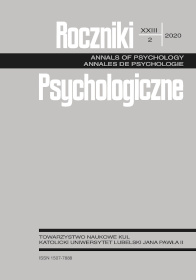Canonical Size for Real-Word Objects in Drawings Performed under Haptic Control
Abstrakt
To date canonical size for physical objects has been exclusively investigated in the visual domain and termed canonical visual size. As the visual and haptic modalities are interconnected in object processing, we have investigated if canonical size occurs in the tactile domain, namely, in embossed drawings made by sighted adults when blindfolded. 17 participants were asked to draw 16 objects of 8 different ranks of physical size. In the visual domain, they drew on sheets of paper, and in the tactile domain, they drew (when blindfolded) on special plastic sheets for embossed graphics haptically controlling the performance with hands. In both the visual and the tactile domain the size of drawings increased linearly with the logarithm of the physical size of real-world objects indicating occurrence of canonical size effect in both domains. Our findings demonstrated that canonical size is not only visual in character but that it is also revealed in a haptic drawing task. It suggests that spatial images (at least visual and tactile) are shared instead of being unimodal in nature.
Bibliografia
Blazhenkova, O., & Kozhevnikov, M. (2009). The new object–spatial–verbal cognitive style model: Theory and measurement. Applied Cognitive Psychology, 23, 638–663. https://doi.org/10.1002/acp.1473
Craddock, M., & Lawson, R. (2009a). Size-sensitive perceptual representations underlie visual and haptic object recognition. PLoS One, 4, e8009. http://dx.doi.org/10.1371/journal.pone.0008009
Craddock, M., & Lawson, R. (2009b). The effects of size changes on haptic object recognition. Attention, Perception, & Psychophysics, 71, 910–923. http://dx.doi.org/10.3758/APP.71.4.910
Edman, P. K. (1992). Tactile graphics. AFB Press.
Kennedy, J. M. (1993). Drawing and the blind: pictures to touch. Yale University Press.
Konkle, T., & Oliva, A. (2011). Canonical visual size for real-world objects. Journal of Experimental Psychology: Human Perception and Performance, 37, 23–37. http://dx.doi.org/10.1037/a0020413
Konkle, T., & Oliva, A. (2012a). A familiar-size Stroop effect: Real-world size is an automatic property of object representation. Journal of Experimental Psychology: Human Perception and Performance, 38, 561–569. http://dx.doi.org/10.1037/a0028294
Konkle, T., & Oliva, A. (2012b). A real-world size organization of object responses in occipitotemporal cortex. Neuron, 74, 1114–1124. http://dx.doi.org/10.1016/j.neuron.2012.04.036
Lacey, S., & Sathian, K. (2014). Visuo-haptic multisensory object recognition, categorization, and representation. Frontiers in Psychology. https://doi.org/10.3389/fpsyg.2014.00730
Long, B., Konkle, T., Cohen, M. A., & Alvarez, G. A. (2016). Mid-level perceptual features distinguish objects of different real-world sizes. Journal of Experimental Psychology: General, 145, 95–109. http://dx.doi.org/10.1037/xge0000130
Loomis, J. M., Klatzky, R. L., & Giudice, N. A. (2013). Representing 3D space in working memory: Spatial images from vision, hearing, touch, and language. In S. Lacey & R. Lawson (Eds.), Multisensory Imagery (pp. 131–155). Springer. https://doi.org/10.1007/978-1-4614-5879-1_8
Palmer, S. E., Rosch, E., & Chase, P. (1981). Canonical perspective and the perception of objects. In J. Long & A. Baddeley (Eds.), Attention and performance IX (pp. 135–151). Erlbaum.
Pascual-Leone, A., & Hamilton, R. H. (2001). The metamodal organization of the brain. Progress in Brain Research, 134, 427–445. https://doi.org/10.1016/S0079-6123(01)34028-1
Smith, M., Franz, E. A., Joy, S. M., & Whitehead, K. (2005). Superior performance of blind compared with sighted individuals on bimanual estimations of object size. Psychological Science, 16, 11–14. https://doi.org/10.1111/j.0956-7976.2005.00773.x
Szubielska, M. (2015). Mental majorization of figures tactilely explored by sighted and congenitally blind individuals. Roczniki Psychologiczne, 18, 121–132. https://doi.org/10.18290/rpsych.2015.18.1-5en
Szubielska, M., & Bałaj, B. (2018). Mental size scaling of three-dimensional objects perceived visually or tactilely. Advances in Cognitive Psychology, 14, 139–149. https://doi.org/10.5709/acp-0245-5
Szubielska, M., & Möhring, W. (2019). Adults’ spatial scaling: evidence from the haptic domain. Cognitive Processing, 20(4), 431–440. https://doi.org/10.1007/s10339-019-00920-3
Vinter, A., Bonin, P., & Morgan, P. (2018). The severity of the visual impairment and practice matter for drawing ability in children. Research in Developmental Disabilities, 78, 15–26. https://doi.org/10.1016/j.ridd.2018.04.027
Woods, A. T., Moore, A., & Newell, F. N. (2008). Canonical views in haptic object perception. Perception, 37, 1867–1878. http://dx.doi.org/10.1068/p6038
Copyright (c) 2020 Roczniki Psychologiczne

Utwór dostępny jest na licencji Creative Commons Uznanie autorstwa – Użycie niekomercyjne – Bez utworów zależnych 4.0 Międzynarodowe.


